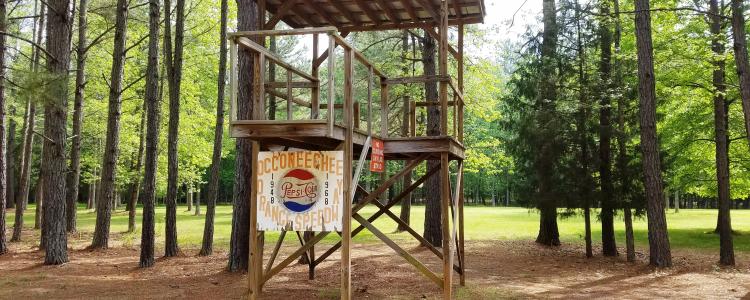The past, as William Faulkner wrote about another Southern place, “is never dead. It's not even past.”
In fact, in Orange County, it’s all around us. In this very modern place, history is still everywhere. Nearly 50 county sites are on the National Register of Historic Places, from downtown historic districts and classic farmhouses to stately colonial residences and re-imagined industrial plants.
Some of the history is renowned — like Old East residence hall on the University of North Carolina campus, the first public university building in the nation, dating from 1793.
While the residence hall looks welcoming, Gimghoul Castle appears forbidding. Off a gravel path at the end of the road in the Gimghoul Historic District, the stone castle’s tower and ramparts make it look like we’re in medieval England.

But this castle was built in the 1920s by a secret society, the Order of Gimghoul. The society was named after a student who mysteriously disappeared from campus in 1833. Maybe he was killed in a duel; no one is quite sure. No one is quite sure either about who’s in the society or what it does. It is, after all, secret.
History is also alive at the nearby Old Chapel Hill Cemetery, even if it focuses on the dead. The graveyard is full of three centuries-worth of headstones and uninscribed fieldstones, monuments and obelisks. It’s a scenic respite from the bustle of campus, complete with dogwoods, azaleas and wisteria.
As I look at the tomb built for “Maidford Manor, in perpetuity, by will and decree of the 39th Lord of Maidford Halse,” two middle-aged men walking nearby call to me. “Hey, do you know where Dean’s grave is?” I don’t, not yet, but I know which Dean they mean: Dean Smith, the legendary Carolina basketball coach is buried here, along with other illustrious figures like the broadcaster Charles Kuralt and band leader Kay Kyser.
While visiting the cemetery feels almost like intruding on a private space, history is evident in some public spaces, too.
Carrboro’s Carr Mill Mall is a small shopping complex listed on the National Register of Historic Places as the Alberta Mill. The 120-year-old brick building was once a cotton mill. The closed mill was supposed to be torn down in the 1970s, but after community opposition, the plan was scrapped and the complex was renovated and reopened.

In this excellent example of creative re-use, you’ll find restaurants and a toy shop, a fabric store and a fragrance boutique. There’s also a coffee shop, Oasis, that with its comfortable couches and air of bohemian insouciance looks like a transplant from New York’s Greenwich Village circa 1955.
While Alberta Mill was utilitarian, the elegant historic homes you can find further north are elegant and decorative.
Moorefields near Hillsborough was built about 1785 and is one of the state’s oldest surviving examples of Federal-style architecture. Described as “an elegant small rural manor house” by the Historic American Building Survey, Moorefields is surrounded by woodlands and permanent pasture maintained as a wildlife refuge.
Not far away is the more formal-looking Ayr Mount. A Federal-style plantation house with an imposing brick front, Ayr Mount was built in 1815. Members of the same family lived there until 1985. Today, you can take guided house tours of the property and see some of the family’s original furnishings.

I walked there recently, on the adjacent one-mile Poet’s Walk. Off in the distance was the toot-toot of a train passing by, which barely broke the beautiful stillness of the place.
There was no stillness back in the day around the nearby Historic Occoneechee Speedway. This was one of the first NASCAR tracks to open and is the only surviving dirt track remaining from the inaugural 1949 stock car season.
Some rusted period stock car wrecks now sit on the infield. The flag stand and the concession stand have been reconstructed. But the track still doesn’t look wide enough for two cars, so you can imagine there must have been a lot of bumpin’ and bangin’ during the early days.

In case you’re wondering, Bob Flock, in a 1948 Oldsmobile, won the first race on the one-mile oval. Richard Petty, the king himself, took 1968’s last race in a 1968 Plymouth.
To the northwest, the bucolic Efland-Cedar Grove Road seems historic itself, a glance back at the county’s agricultural backstory. You drive past weathered barns, farm silos, old tobacco shacks, grazing horses and lazing cattle.
At the intersection with Carr Store Road is the Cedar Grove Rural Crossroads Historic District, some 44 scattered buildings, including a battered grocery dating from the 1880s, a long-closed tractor repair shop and a still operating country post office.
The crossroads looks deserted until a woman arrives, laden with holiday presents to mail. Today meets yesterday, like it does throughout Orange County.
(Gimghoul Castle photo credit : CarolinaPickinandDecor on Instagram)

